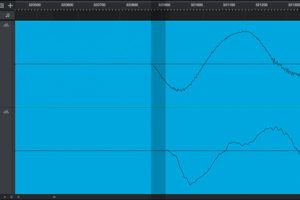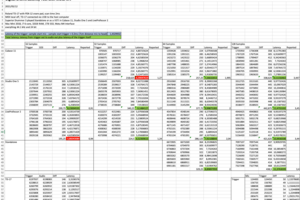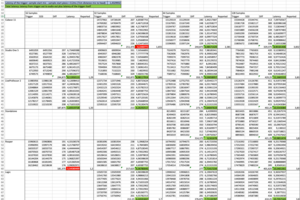Digital Drums Latency Test II
aka does RME really shoot out Motu?
Playing a VSTi like Superior Drummer with a digital drum set can be much fun as long as you get the latency low. The lower the better, so in the first step I went for a Motu M4 because early tests showed that the "lowest latency in this price range"-marketing was not just marketing. To know what's really going on I did a test with various hosts and measured the real life latency from hitting the pad to hearing the sound. Results below, I felt pretty happy with my setup. But...
There was always this "What is it about those RME and are they really worth it?" in my mind so I couldn't resist and got myself a Babyface Pro FS. And to see if it's worth all that extra money I redid the test and took the chance to add two more DAWs to the list of hosts. So here we go:
Setup
- Roland TD-17 with PDX-12 snare pad, scan time 2ms
- MIDI local off, TD-17 connected via USB to the host computer
- Superior Drummer 3 played Standalone or as a VSTi in Cubase 11, Studio One 5, LiveProfessor 2, Reaper 6 and Logic 10.5
- Mac Mini 2018, i7 6-core, 32GB RAM, 1TB SSD
- Motu M4 vs RME Babyface Pro FS, both with latest drivers (May/June 2021)
- everything 44.1 kHz and 24 bit
1. Checking sample starting points
To find out if Superior Drummer has any latency due to wrong sample starting points I set 1 MIDI note on every count of a bar (exactly in grid), sent them to a snare sound in SD3 and rendered the SD3 instrument track. All done in Cubase, the resulting waveform shows that the samples are cut exactly at the starting point of the waveform. I repeated the test 8 times to see if different round robin samples will differ but all results are equal.
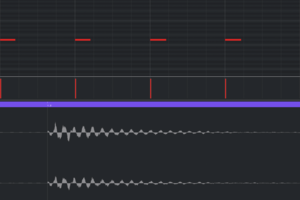
2. Yes, triggers have a latency
Haven't had this in mind when doing the test but someone at the vdrums forum pointed this out and he's absolutely right: Triggers take their time from being hit to send out an impulse. Don't wanna go into details as I'm not sure if I would get them right. But I placed a mic on spot of the drum head, hit the pad and recorded both the mic and the trigger signal. In result there is a slight delay between the two signals of about 1.2ms. Considering the distance of the mic to the head the resulting latency between the actual strike and the impulse given by the trigger is about 1.4ms. I will NOT repeat tho whole tests with the mic, sorry... But to get real real life numbers I added the result of the mic-vs-piezo-test in the Excel tables below.
3. Setting up laptop as a recorder
For the recording I set up a second computer (Macbook Air) with Studio One and an older Presonus interface. It's not important what exact computer/interface/DAW is used here. The goal is to have a recorder that's independent from the test setup and any of it's delay compensation things. Then I put a splitter cable in the trigger output of the snare pad and sent one signal to input 2 of the Presonus interface, the other one to the trigger input of the TD-17. From there it went through USB-MIDI to the Mac Mini to trigger SD3 in various hosts. The audio out of the Mini was sent to input 1 of the Presonus interface. In result I get two mono tracks with the waveforms of the trigger on the pad and the snare sample coming out of SD3.

4. Measuring the latency
In every host I did the test with buffer sizes from 16 samples (or the lowest available buffer size) up to 128 samples. An earlier test showed that anything higher than 128 leads to latencies that make live drumming impossible, the interesting things happen below 64. By measuring and comparing the starting points of the two waveforms you get the delay between the moment the trigger fires to the moment the sound comes out of the computer. By adding the latency of the trigger you get the exact real life latency when playing a VSTi. I read the sample number of the starting points of the waveforms, copied them to an Excel sheet and let Excel do the calculations. This process was done 8 times for every host with every buffer size to level jitters and inaccuracies.
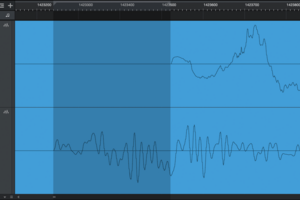
5. The results
Ok, so here all the numbers. You don't need to go through all cells of the table, I just wanted to show in detail what values I got. The important numbers are the highlighted ones as they show the real life latency "from strike to sound". Some of them are marked red as I got some crackles with that buffer sizes. The first screenshot shows the Motu, the second one the RME. Overall the latencies with the RME seem to be a little bit lower but I wouldn't take this too serious. Some of the values differ more within one test-setup than between the interfaces. But yes, the RME is potentially a little bit faster than the Motu. Where the RME really beats the Motu is the low latency performance. Not only can I play LiveProfessor with 16 samples (really!) without any crackels, additionally I can play tracks from iTunes without the slightest hickup. With the Motu the iTunes playback was stuttering here and there even with 64 samples. The Babyface really changes the game at this point.
6. Conclusion (sort of)
For the overall latency there come four main things in a row: the latency of the trigger itself, the scan time of the drum module, the time it takes to get the note-on from the module to the VSTi and render the sound, plus the output latency of the audio interface. The reported latency you read in the host is only the last of these four. So if your DAW let's you go down to 16 samples and 0.91ms that's only half (or quarter...) of the truth. There's nothing wrong with it, just keep it in mind if you argue with other e-drummers. You always have to add aboud 5ms to the reported output latency at least, even more with some hosts. If you want to go for the last 1ms you should definitely look for a fast host. I will use LiveProfessor for live drumming, it's fast and has a great low latency performance.
The audio interface is the second crucial thing if you wanna go really low. Of course there are many interfaces on the market and some of them may perform good enough for most scenarious. In my opinion you can have a good time with playing at 10ms latency, you don't really hear the delay. But you can feel the difference between 10 and 6, it feels more natural, punchier, smoother - and therefore it's more fun to play. I would always recommend a dedicated decent audio interface instead of something like onboard devices with ASIO4ALL.
7. What about the TD-17 itself?
OK, and what are those TD-17 numbers in the tables? To compare the VSTi setup with the TD-17 internal latency I simply put the jack into the TD-17 master out and recorded it in the same test scenario. Except, as there aren't any buffer settings, there is only one result: 4.4ms. I think this is pretty much how fast it can get with todays digital drums: 1.4ms trigger latency plus 2ms scan time plus 1ms audio output latency. That's pretty much the delay from an acoustic kick to the ear of the drummer. At least as long as you play with headphones plugged directly into the drum module.
8. Famous last words
So given that there are some inaccuracies and jitters I can play Superior Drummer with a latency less than 2ms higher than the internal sounds. Makes me feel pretty happy with all my gear and was worth some extra steps. :-)
8a. Is the RME worth the extra money?
Well, you have to decide for yourself. As I said, I was really happy with the Motu, it's sound and performance are really good and maybe one of the best in that price range. And from being a long time Motu user I would expect a good driver support for the next years. But the Babyface is simply better - in many ways. It's not so much the sound (wouldn't spend 440,- extra EUR for that, the Motu sounds really good), but the sum of all the little things: build quality, Totalmix, driver support, expandability, latency and especially the low latency performance. It gives you this feeling of "never have to think about anything else".
Addendum
In an earlier version I tested the TD-17 audio driver vs the Motu M4 and went up to 512 Samples. I measured the latencies in ms with some inaccuracies and placed a mic in front of the head instead of recording the signal directly from the trigger. One output of this first test was: playing with the TD-17 as an interface isn't that bad, the latency is 2-3ms higher than the Motu. But this is only on the Mac and because of it's Core Audio architecture. This maybe different with Windows where you need a sound device with ASIO drivers. Furthermore it showed that a buffer of more than 128 samples leads to latencies significantly too high for live playing.

